
By Chris Becker
The banking sector is facing tough conditions in the medium term as a variety of macro factors intersect: a declining demographic profile exarcebated by rising unemployment in the medium term, lower private credit growth in the form of disleveraging (that has the potential to fall into outright deleveraging, like business finance), structurally high funding costs, competition over deposits, a Federal Government going to surplus in record time and of course, the ongoing house price melt from 2010.
But this has not stopped investors embarking on a chase for juicy, sweet dividends, sending the financial (ex-property trusts) sector up 20% from its low in June – and driving most of the increase in the ASX200 (in red below):
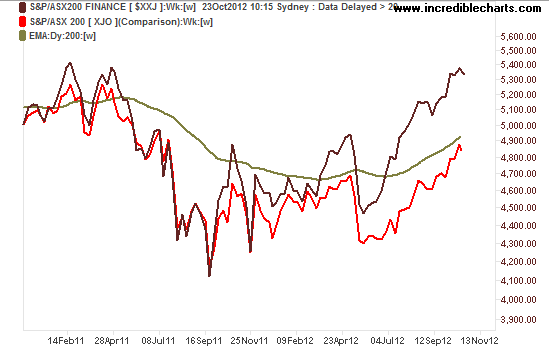
At MacroInvestor, we provide estimates of value of each of the four banks on a weekly basis in our StockTake section; ANZ, Commonwealth, National and Westpac – or as we like to call them “Megabank” as they are really just one entity supported by government.
We also covered Commonwealth Bank (CBA) in detail in mid-August, where FARM (our proprietary investing program) calculated a “Buy” signal that was then negated by the lack of a “margin of safety” between its FY13 estimate of value (just under $60), future estimates of value and the current price. In other words, it remains a speculative play only, regardless of the dividend:
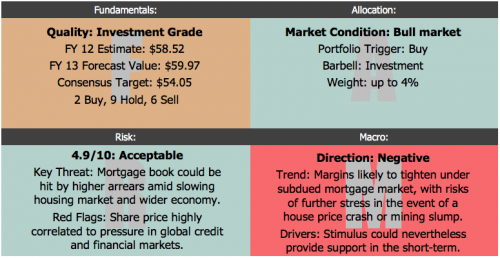
And in the same issue, National Australia Bank (NAB), which has an Avoid quality rating from the get-go, thus negating any reason to invest in it, regardless of a positive macro or technical picture:
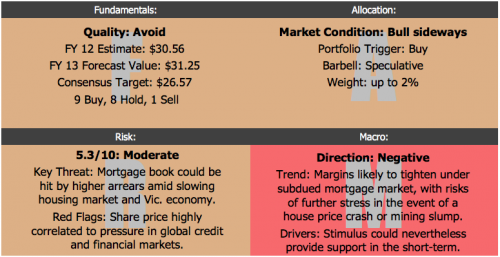
Beyond an investing thesis however, there is always the opportunity to make shorter term buy/short decisions with banks. One such shorting opportunity came about as recently as early last month, to take advantage of a possible rotation out of the financial sector and into materials and even industrials stocks that have been waylaid by a very expensive Australian dollar.
This price catalyst has not yet come to pass, but dark clouds may yet be approaching, according to Goldman Sachs via The Age:
Westpac and NAB have been downgraded by investment bank Goldman Sachs on concerns lower loan growth and a weaker margins would limit share price growth.
In the latest bearish signal for the banking sector, Goldman Sachs lowered its rating on Westpac from “neutral” to “sell” as the outlook for returns softens.
“We expect Westpac’s second half result to highlight a relatively weaker trend in pre-provision operating profit growth than peers at 1.2 per cent half-on-half,” wrote Goldman Sachs’ banking analyst Benjamin Koo in a note to clients.
In the same time, PPOP growth was forecast to be 1.7 per cent at ANZ and 4.3 per cent at NAB by comparison, according to Goldman Sachs.
“Looking past Westpac’s result, we expect easing financial conditions to provider greater growth options outside the banking sector, as increased funding constraints created a ‘handbreak’ on revenue growth,” Mr Koo said.
This is on the back of NAB’s latest quarterly result where they flagged a $250 million increase in provisions for bad and doubtful debts – paltry in our opinion – and a swath of downgrades have followed from the major brokerage/analyst houses.
Here’s FARM’s updated view on the banking sector to put this into perspective:
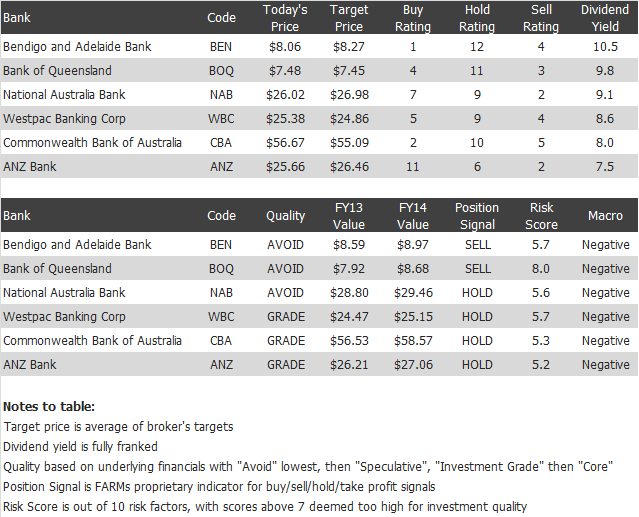
Note that FARM’s June 2013 estimate of value is at or below the current share price, with FY2014 estimates less than 4% higher on average. There is no margin of safety here at all – and these valuations are based on usually quite bullish brokerage estimates amidst near emergency-like interest rate cuts.
In fact, the valuation for Commonwealth Bank (CBA), the strongest of the four, has declined from just under $60 to $56.53 since our August review:
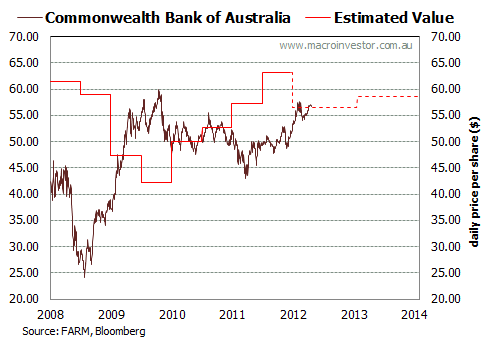
Our thesis remains that the banking sector is unlikely to experience sufficient real earnings growth to offset a structural increase in funding costs and rising provisions. Current year earnings growth will average only 2%, according to consensus estimates, with FY2014 earnings growing at just over 4% year-on-year.
With Goldman Sachs saying that higher yields “were now more than priced in”, even though a sizeable 2.5% to 4% spread exists to the highest paying term deposits, is that enough to offset the negative macro conditions the banks face in the long run, and the very low growth in valuations?
Perhaps its time to find value – and growth opportunities – elsewhere.
Chris Becker is an investment strategist at Macro Investor, Australia’s leading independent investment newsletter covering stocks, trades, property and fixed interest.
A free 21-day trial is available at the site.
You can follow Chris on Twitter.
Disclaimer: The content on this blog should not be taken as investment advice. All site content, including advertisements, shall not be construed as a recommendation, no matter how much it seems to make sense, to buy or sell any security or financial instrument, or to participate in any particular trading or investment strategy. The authors have no position in any company or advertiser reference unless explicitly specified. Any action that you take as a result of information, analysis, or advertisement on this site is ultimately your responsibility. Consult someone who claims to have a qualification before making any investment decisions.